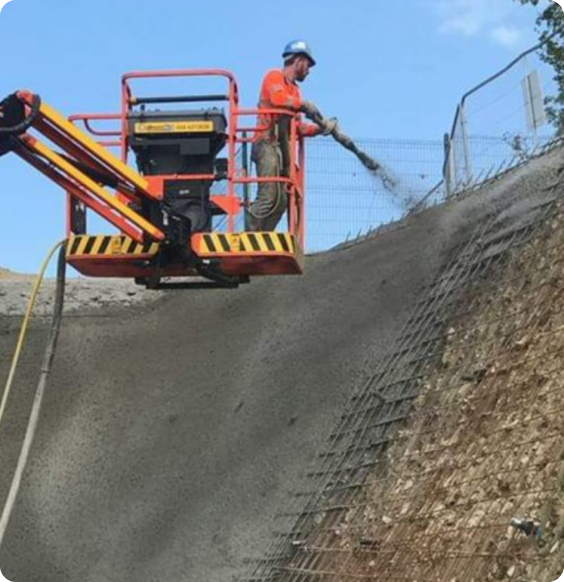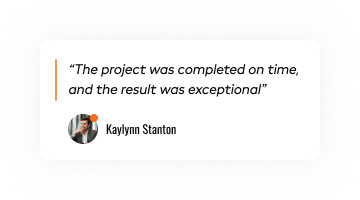Shotcrete is a method of applying concrete or mortar through a high-pressure hose onto a surface. It is commonly used in construction and repair projects, particularly for structures like swimming pools, tunnels, retaining walls, and slope stabilization. The process involves spraying a mixture of cement, aggregates, and water onto a surface, often reinforced with steel mesh or other reinforcement materials.
Shotcrete Information:
Shotcrete offers several advantages that make it a preferred construction method in various scenarios:
 Rapid Construction:
Rapid Construction:
Shotcrete allows for quick and efficient construction since it can be applied rapidly, especially in comparison to traditional methods like cast-in-place concrete. This can lead to shortened project timelines.
 Adaptability to Complex Shapes:
Adaptability to Complex Shapes:
The high velocity at which shotcrete is applied enables it to adhere to a variety of surfaces, including vertical and overhead areas. This adaptability makes it suitable for constructing structures with complex shapes and contours.
 Enhanced Bonding and Adhesion:
Enhanced Bonding and Adhesion:
The force with which shotcrete is propelled onto a surface ensures excellent bonding, resulting in a strong connection between the shotcrete and the substrate. This feature is advantageous for structural stability.
 Reduced Formwork Requirements:
Reduced Formwork Requirements:
Unlike traditional cast-in-place concrete, shotcrete often requires minimal or no formwork. This can reduce labor and material costs, making it a cost-effective option for certain projects.
 Improved Strength and Durability:
Improved Strength and Durability:
Shotcrete typically exhibits high compressive strength and durability. The process allows for the effective consolidation of the concrete mix, contributing to the overall strength of the structure.
 Flexibility in Mix Design:
Flexibility in Mix Design:
Shotcrete mix designs can be tailored to meet specific project requirements. This flexibility allows for the incorporation of various additives and reinforcements to enhance properties such as durability, shrinkage resistance, and crack control.
 Erosion Control and Slope Stabilization:
Erosion Control and Slope Stabilization:
Shotcrete is often used for stabilizing slopes, preventing erosion, and reinforcing structures in areas prone to landslides. Its ability to adhere to irregular surfaces makes it effective in such applications.
 Cost-Effective in Certain Applications:
Cost-Effective in Certain Applications:
The reduced need for formwork and the quick application process can contribute to cost savings in certain situations. Additionally, the potential for reduced labor costs due to faster construction can make shotcrete economically viable.
 Versatility:
Versatility:
Shotcrete can be used in a variety of construction projects, including building construction, tunneling, swimming pool construction, and repair work. Its versatility makes it a valuable solution for different applications.
 Repair and Rehabilitation:
Repair and Rehabilitation:
Shotcrete is often used for repairing and rehabilitating existing structures, providing a durable and efficient solution for restoring damaged surfaces.

Shotcrete Types
There are two main types of shotcrete:
 Dry-Mix Shotcrete (also known as Gunite):
Dry-Mix Shotcrete (also known as Gunite):
In this method, the dry ingredients (cement and aggregates) are pre-mixed, and only water is added at the nozzle during application. Compressed air
propels the mixture through the hose onto the surface.
 Wet-Mix Shotcrete:
Wet-Mix Shotcrete:
In this method, the dry ingredients (cement and aggregates) are pre-mixed, and only water is added at the nozzle during application. Compressed air propels the mixture through the hose onto the surface.
The high velocity at which shotcrete is applied allows for excellent adhesion to the receiving surface, making it suitable for vertical or overhead applications. It is known for its efficiency, strength, and durability, making it a popular choice in various construction scenarios. The flexibility of shotcrete application also allows for shaping and contouring to match the specific requirements of the project.


There are several alternatives to shotcrete, depending on the specific requirements and conditions of a construction project. Some common alternatives include:
 Traditional Cast-in-Place Concrete:
Traditional Cast-in-Place Concrete:
This involves pouring concrete into formwork on-site and allowing it to cure and harden in place. It’s a conventional method that is often used for a wide range of construction projects.
 Precast Concrete:
Precast Concrete:
Concrete elements are cast in a controlled environment (usually a factory) and then transported to the construction site for installation. Precast concrete can be more cost-effective and offer higher quality control.
 Traditional Cast-in-Place Concrete:
Traditional Cast-in-Place Concrete:
This involves pouring concrete into formwork on-site and allowing it to cure and harden in place. It’s a conventional method that is often used for a wide range of construction projects.
 Gunite:
Gunite:
Gunite is a type of sprayed concrete similar to shotcrete. However, it typically involves a dry mix of sand and cement, which is mixed with water at the nozzle before being sprayed onto the surface.
 Fiber-Reinforced Concrete:
Fiber-Reinforced Concrete:
Adding fibers, such as steel or synthetic fibers, to the concrete mix can enhance its tensile strength and reduce cracking. Fiber-reinforced concrete is often used as an alternative to shotcrete in certain applications.
 Flowable Fill:
Flowable Fill:
Also known as controlled low-strength material (CLSM) or flowable mortar, this is a self-leveling mixture of cement, fly ash, sand, water, and sometimes additives. It is often used for backfilling, filling voids, and as a substitute for conventional compacted fill materials.
 Rammed Earth:
Rammed Earth:
Rammed earth construction involves compacting a mixture of earth, chalk, lime, or gravel between forms to create solid walls. It’s a sustainable and energy-efficient alternative for certain types of structures.
 Sprayed Mortar:
Sprayed Mortar:
Similar to shotcrete, sprayed mortar involves the application of mortar onto a surface using high-pressure equipment. It may be used in scenarios where the benefits of shotcrete are not necessary.
The choice of alternative will depend on factors such as project specifications, site conditions, budget constraints, and the desired properties of the finished structure. Each method has its advantages and limitations, and the selection should be based on a careful consideration of the project requirements and goals.


Shotcrete Features
Shotcrete offers several advantages that make it a preferred construction method in various scenarios:
 Rapid Construction
Rapid Construction
Shotcrete allows for quick and efficient construction since it can be applied rapidly,
 Adaptability to Complex Shapes
Adaptability to Complex Shapes
The high velocity at which shotcrete is applied enables it to adhere to
 Enhanced Bonding and Adhesion
Enhanced Bonding and Adhesion
The force with which shotcrete is propelled onto a surface ensures excellent bonding

Alternative to Shotcrete
There are several alternatives to shotcrete, depending on the specific requirements and conditions of a construction project. Some common alternatives include:
 Traditional Cast-in-Place Concrete
Traditional Cast-in-Place Concrete
This involves pouring concrete into formwork on-site and allowing it to cure and harden in place. It’s a conventional method that is often used for a wide range of construction projects.
 Precast Concrete:
Precast Concrete:
Concrete elements are cast in a controlled environment (usually a factory) and then transported to the construction site for installation. Precast concrete can be more cost-effective and offer higher quality control.
 Gunite:
Gunite:
Gunite is a type of sprayed concrete similar to shotcrete. However, it typically involves a dry mix of sand and cement, which is mixed with water at the nozzle before being sprayed onto the surface
Book Consultation Fiber-Reinforced Concrete:
Fiber-Reinforced Concrete:
Adding fibers, such as steel or synthetic fibers, to the concrete mix can enhance its tensile strength and reduce cracking. Fiber-reinforced concrete is often used as an alternative to shotcrete in certain applications.
 Flowable Fill:
Flowable Fill:
Also known as controlled low-strength material (CLSM) or flowable mortar, this is a self-leveling mixture of cement, fly ash, sand, water, and sometimes additives. It is often used for backfilling, filling voids, and as a substitute for conventional compacted fill materials.
 Rammed Earth:
Rammed Earth:
Rammed earth construction involves compacting a mixture of earth, chalk, lime, or gravel between forms to create solid walls. It’s a sustainable and energy-efficient alternative for certain types of structures.
 Sprayed Mortar:
Sprayed Mortar:
Similar to shotcrete, sprayed mortar involves the application of mortar onto a surface using high-pressure equipment. It may be used in scenarios where the benefits of shotcrete are not necessary.
The choice of alternative will depend on factors such as project specifications, site conditions, budget constraints, and the desired properties of the finished structure. Each method has its advantages and limitations, and the selection should be based on a careful consideration of the project requirements and goals.
